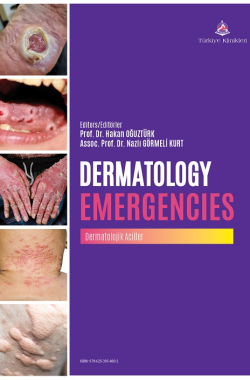Meningococcemia
Adil Emre GEZER
Ankara Etlik City Hospital, Clinic of Emergency Medicine, Ankara, Türkiye
Gezer AE. Meningococcemia. In: Oğuztürk H, Görmeli Kurt N, eds. Dermatologic Emergencies. 1st ed. Ankara: Türkiye Klinikleri; 2025. p.55-9.
ABSTRACT
Meningococcemia is an infection caused by Neisseria meningitidis. It is the most important bacterium among the causes of bacterial meningitis in adults and children. Neisseria meningitidis is a major cause of bacterial meningitis worldwide. Meningococcemia can present as sepsis and bacteremia. Clinical manifestations of meningococcemia can range from mild symptoms to severe conditions that can lead to sudden death. Early diagnosis is critical for initiating appropriate antibiotic therapy and supportive care. For early diagnosis, the presence of rashes with fever should raise the possibility of meningococcal infection. Rashes are generally characterized by petechial rashes on the skin and mucous membranes. These petechial rashes eventually develop into palpable purpura and may merge and lead to the development of purpura fulminans. Palpable purpura is a pathognomonic finding for meningococcemia. Meningococcal disease can occur both endemically and epidemically worldwide. Today, with the increase in vaccination practices, the incidence of meningococcemia has decreased significantly. In patients suspected of having meningococcemia, ceftriaxone should be chosen as the first choice treatment without delay. In patients with a confirmed or suspected diagnosis of meningococcemia, isolation is recommended only for the first 24 hours after ceftriaxone treatment. Bacteria cannot be detected in the human body 1 day after starting treatment. Ciprofloxacin, rifampin and ceftriaxone should be preferred for prophylaxis.
Keywords: Meningitis; meningococcal; skin disorders; purpura
Kaynak Göster
Referanslar
- Durand ML, Calderwood SB, Weber DJ, Miller SI, Southwick FS, Caviness VS Jr, et al. Acute bacterial meningitis in adults. A review of 493 episodes. N Engl J Med. 1993;328(1):21-8. [Crossref] [PubMed]
- Salzman MB, Rubin LG. Meningococcemia. Infect Dis Clin North Am. 1996;10(4):709-25. [Crossref] [PubMed]
- Waterfield T, Dyer EM, Lyttle MD. Fifteen-minute consultation: the child with a non-blanching rash. Arch Dis Child Educ Pract Ed. 2018;103(5):236-40. [Crossref] [PubMed]
- Mbaeyi SA, Bozio CH, Duffy J, Rubin LG, Hariri S, Stephens DS, et al. Meningococcal Vaccination: Recommendations of the Advisory Committee on Immunization Practices, United States, 2020. MMWR Recomm Rep. 2020;69(9):1-41. [Link]
- MacNeil JR, Blain AE, Wang X, Cohn AC. Current Epidemiology and Trends in Meningococcal Disease-United States, 1996-2015. Clin Infect Dis. 2018;66(8):1276-81. [Crossref] [PubMed]
- Cohn AC, MacNeil JR, Clark TA, Ortega-Sanchez IR, Briere EZ, Meissner HC, et al.; and Immunization, Centers for Disease Control and Prevention (CDC). Prevention and control of meningococcal disease: recommendations of the Advisory Committee on. Prevention and Control of Meningococcal Disease. Morbidity and Mortality Weekly Report: Recommendations and Reports. 2013;62(2):1-28 [Link]
- Rosenstein NE, Perkins BA, Stephens DS, Popovic T, Hughes JM. Meningococcal disease. N Engl J Med. 2001;344(18):1378-88. [Crossref] [PubMed]
- de Vries FP, van Der Ende A, van Putten JP, Dankert J. Invasion of primary nasopharyngeal epithelial cells by Neisseria meningitidis is controlled by phase variation of multiple surface antigens. Infect Immun. 1996;64(8):2998- 3006. [Crossref] [PubMed] [PMC]
- Gardner P. Clinical practice. Prevention of meningococcal disease. N Engl J Med. 2006;355(14):1466-73. Erratum in: N Engl J Med. 2007;356(5):536. [Crossref] [PubMed]
- Schwentker FF Gelman S, Long PH. The treatment of meningococcic meningitis with sulfanilamide: Preliminary report. JAMA. 1937;108(17):1407-8. [Crossref]

